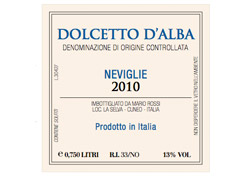1 - Specific region from which the product comes
Indicates the geographical area from which the product comes (e.g. Alba), which may be accompanied by a reference to the related vine (e.g. Dolcetto).
Indicates the geographical area from which the product comes (e.g. Alba), which may be accompanied by a reference to the related vine (e.g. Dolcetto).
The expressions Controlled Designation of Origin (D.O.C. [CDO]) or Controlled and Guaranteed Designation of Origin (D.O.C.G. [CGDO]) mean that it is a highly qualified product, obtained observing the strict rules that ensure a high quality. This information may be accompanied by the acronym D.O.P. [PDO], which defines, at European level, the Wines with Designation of Origin.
The nominal volume of wine must be stated in litres, centilitres or millilitres.
Starting from the 2010 harvest, the indication of the year is mandatory for all D.O.C.G. [CGDO] and D.O.C. [CDO] wines, except for sparkling, fizzy and fortified wine types.
Any reference to the corresponding manufacturer and/or bottler should always be specified (alternatively, for imported wines, the importer or retailer) including company its name and location of the production plant. In addition, it is possible to use a code (where prescribed in the Member State) that further identifies one of these subjects.
The term “produced in” (or equivalent terms such as “wine of”, “product of”, etc.) followed by the name of the Member State, indicate the area where the grapes were harvested and vinified.
A numbering that indicates a set of bottles belonging to the same lot or parcel, produced in virtually identical circumstances. As a rule, it is usually preceded by the letter “L”.
On the containers or labels of the products put on the market there should also appear an invitation not to dispose of the containers in the environment after use.
Indicates that the product was treated with allergens such as sulphur dioxide.
The alcohol content must be expressed in units or half units of percentage by volume (e.g. 10% vol., 10.5% vol.) and may be preceded by the wording “actual alcoholic strength’’ or “actual alcohol’’ or just by the abbreviation “alc’’.

The label applied on a bottle can be regarded as the identity card of the wine, and therefore must contain precise details and illustrations specially designed to help the consumer understand the true nature of the product it refers to.
The label takes, therefore, an important significance, since it determines the first contact of the consumer with the wine. Actually, in current commercial reality, the only message that the bottler may get to those who will drink the product consists of the information provided on the label.
The label thus transmits a whole series of important information about the wine and its characteristics. Such information must be clear, complete and verifiable.
The European Community issued in this regard a series of precise rules in or- der to create uniform legislation at European level.
The EC legislation brings together wines with D.O.C. [CDO] and D.O.C.G. [CGDO] labels under one acronym, i.e. D.O.P. [PDO] (Protected Designation of Origin).